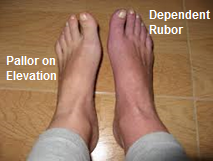Dependant Rubor
1. [noun] dependent rubor is a fiery to dusky-red coloration visible when the leg is in a dependent position but not when it’s elevated above the heart. The underlying cause is peripheral arterial disease (PAD), so the extremity is cool to the touch. One test for dependent rubor, position the patient supine and elevate the legs 60 degrees for 1 minute; then examine sole color. PAD causes the soles to change from pink to pale in fair-skinned people and to gray or ashen in dark-skinned people. The faster the pallor appears, the worse the PAD. Pallor within 25 seconds of leg elevation indicates severe occlusive disease, which warrants further evaluation for potential revascularization. Next, observe skin color changes with the patient in a sitting position. Normally, the foot and leg should remain pink with elevation and dependency. In PAD, the color changes from pale to pink and then progresses to purple-red or bright red. The longer dependent rubor takes to reappear, the worse the PAD. Rubor that appears in 25 to 40 seconds indicates severe ischemia. If rubor disappears quickly with elevation and returns in less than 25 seconds, consider the possibility that the patient has venous reflux, not PAD. In this case, pooled blood causing the rubor drains rapidly from the veins when the leg is elevated and regurgitates back into the tissues when the leg is dependent. If you detect dependent rubor, obtain the ankle-brachial index ( ABI ) to confirm PAD. See: https://woundcareadvisor.com/whats-causing-your-patients-lower-extremity-redness_vol2-no4/ ; Accessed May 19 2019

Frequently Asked Questions
How can natural foot color shifts with leg positioning offer clues about vascular conditions?
When the leg is lowered, a healthy circulation maintains a consistent pink tone. In cases of vascular issues, a shift toward a dusky-red tint may be observed, highlighting a departure from normal arterial and venous performance.
How can everyday changes like leg elevation during rest reveal subtle differences in foot blood flow?
In routine positions, such as lying with feet elevated, variations in foot color may become noticeable. These changes can subtly indicate differences in blood flow dynamics without stressing the entire condition.
How does venous reflux contrast with the color changes seen in dependent rubor when examining the feet?
With dependent rubor, color changes develop gradually with leg position due to differences in arterial flow. In contrast, venous reflux shows rapid draining and re-coloration, underscoring a different underlying vascular mechanism.
How does the Latin root of 'rubor' serve as a mnemonic when assessing foot color in circulation checks?
The word 'rubor' comes from Latin for red, serving as a memory aid to note abnormal red discoloration in the foot. This connection can help distinguish normal skin tones from those affected by altered circulatory responses.